Steven Nzonzi joined up with Stade Rennais late on in this past January’s transfer window as he prematurely ended his loan spell with Galatasaray from Serie A side AS Roma and took up an option to return to his home nation of France and become a part of Julien Stéphan’s Rennes side.
Following the cancellation of the 2019/20 Ligue 1 season, Nzonzi will remain a Rennes player until the end of the 2020/21 campaign as Les Rouges et Noir have qualified for next season’s UEFA Champions League.
While Nzonzi has only featured in five Ligue 1 games for Rennes since joining the club in January, the 31-year-old midfielder has made a noticeable impact for the club on the pitch and he has fit nicely into Stéphan’s tactics since making his move to Rennes.
In this tactical analysis piece in the form of a scout report, we will examine the role that Nzonzi has played for Rennes since joining the club back in January. We will attempt to provide a tactical analysis of Nzonzi’s role for Rennes both in and out of possession and we will attempt to show how impressive his performances for the club have been during his brief time at Roazhon Park.
Nzonzi’s position and its significance to Rennes’ tactics
To kick off this tactical analysis on Steven Nzonzi at Rennes, we are going to simply look at the position that the 31-year-old Frenchman has played within Stéphan’s tactics thus far and attempt to explain how significant the positions that he has taken up have been for his side’s overall style of play and how his role has helped to create a greater balance for Rennes.
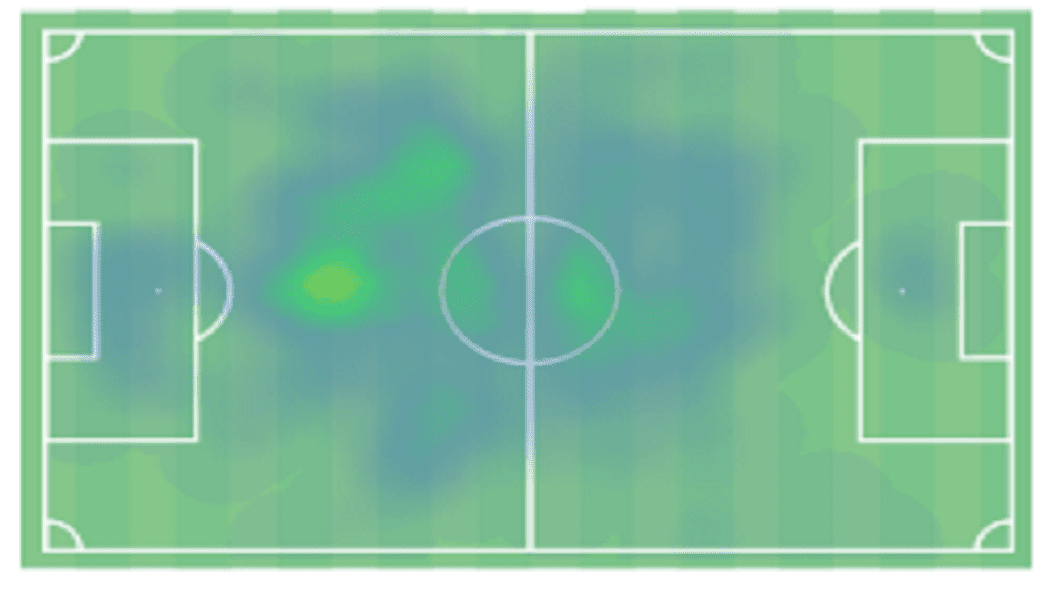
This image above shows us an average overall heatmap for Nzonzi’s five Ligue 1 games at Rennes this term. We can see here that the 31-year-old has mainly occupied a central position just in front of his own box, while he has also spent some time on the left-hand side of central midfield.
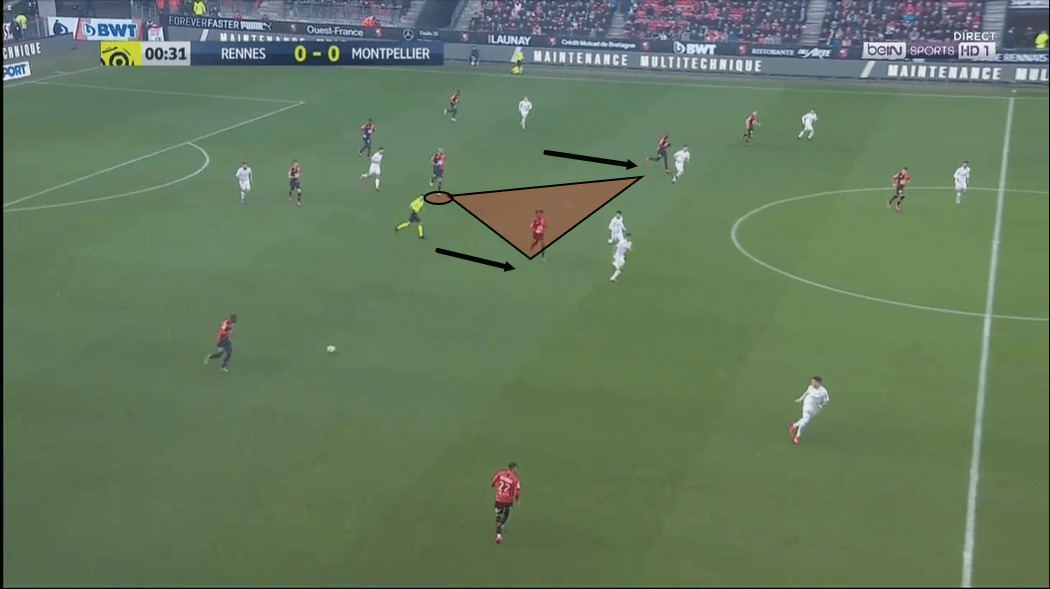
We can see an example of Nzonzi occupying this central position within Rennes’ 4-3-3 from their most recent Ligue 1 clash, a 5-0 win over Montpellier, in the image above. Nzonzi started at the base of a midfield three alongside James Léa Siliki, positioned to his left, and Eduardo Camavinga, positioned to his right.
Rennes have rarely played with a 4-3-3 system this season. Les Rouge et Noir have mainly played with two central midfielders throughout the 2019/20 campaign, lining up in a 4-4-2 in 59.4% of their Ligue 1 games this term. Only Angers have lined up in their preferred 4-1-4-1 formation in a higher percentage of Ligue 1 games than Rennes have lined up in their 4-4-2 this term, indicating just how heavily they have favoured this system.
Camavinga and Léa Siliki were the typical midfield pairing for Rennes during the 2019/20 season, however, Nzonzi’s arrival in January gave the team another top-quality option in central midfield and gave them the option of playing with a third man in the middle of the park.
The addition of Nzonzi to Rennes gave them the option of sitting him behind the pairing of Camavinga and Léa Siliki, as he did in this game versus Montpellier. While it would be incorrect to say that Rennes have switched to a 4-3-3 shape since Nzonzi’s arrival, it would be fair to say that his arrival has given them more options and this midfield trio worked well to help Les Rouge et Noir to secure a 5-0 victory on this occasion indicating that it may have been a successful experiment and a sign of things to come for Stéphan’s side.
One of the important things that Nzonzi has brought to Rennes since joining them in January is how his presence as an experienced, holding midfielder has allowed Camavinga to enjoy an increased amount of freedom within Stéphan’s tactics.
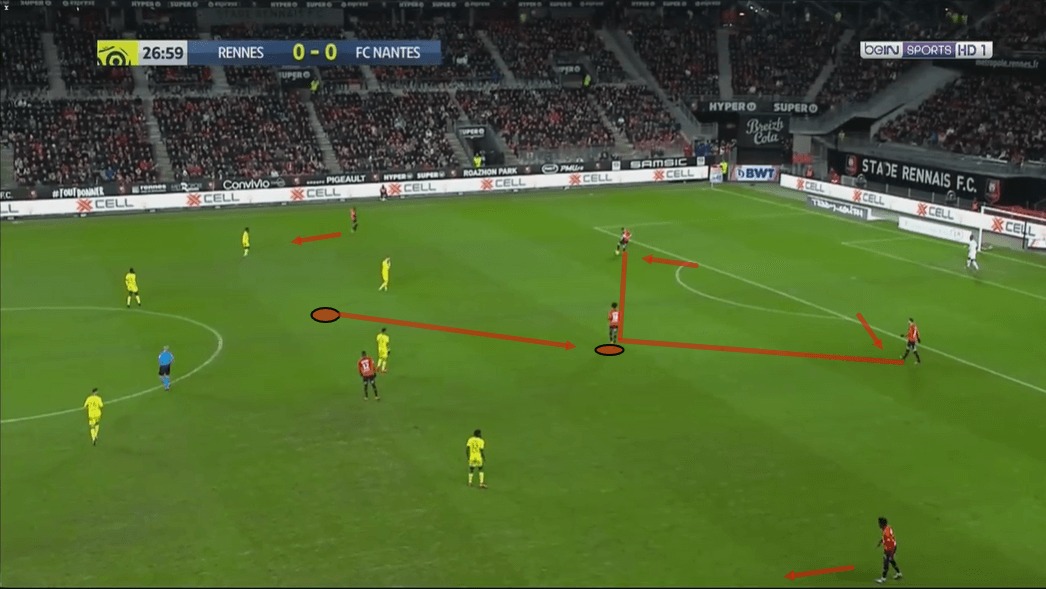
In Rennes’ build-up tactics, one midfielder often drops between the centre-backs into the defensive line during the build-up phase. We can see an example of Camavinga performing this role, as he often has this season, in a Ligue 1 clash with Nantes prior to Nzonzi making his debut for the club.
Just prior to this image being taken, the 17-year-old midfielder vacated his spot on the left of central midfield to help his side during the build-up by sitting himself in between the centre-backs to create a 3v2 advantage for his side in this area of the pitch versus Nantes’ two centre forwards.
Camavinga often found himself performing this role, likely due largely to his technical ability. The young Frenchman is an impressive all-around midfielder who is capable of performing in a variety of roles within the midfield and his technical ability, combined with his defensive quality and the safety net that he can offer his side when sitting deeper and joining the defence as shown here, make him an essential asset for Les Rouge et Noir.
However, as previously mentioned, Camavinga is capable of influencing the game for his side in a variety of different ways and while he can perform effectively in the role that we see him in above, performing that role does make it more difficult for him to utilise his dribbling ability and his playmaking quality inside the final third.
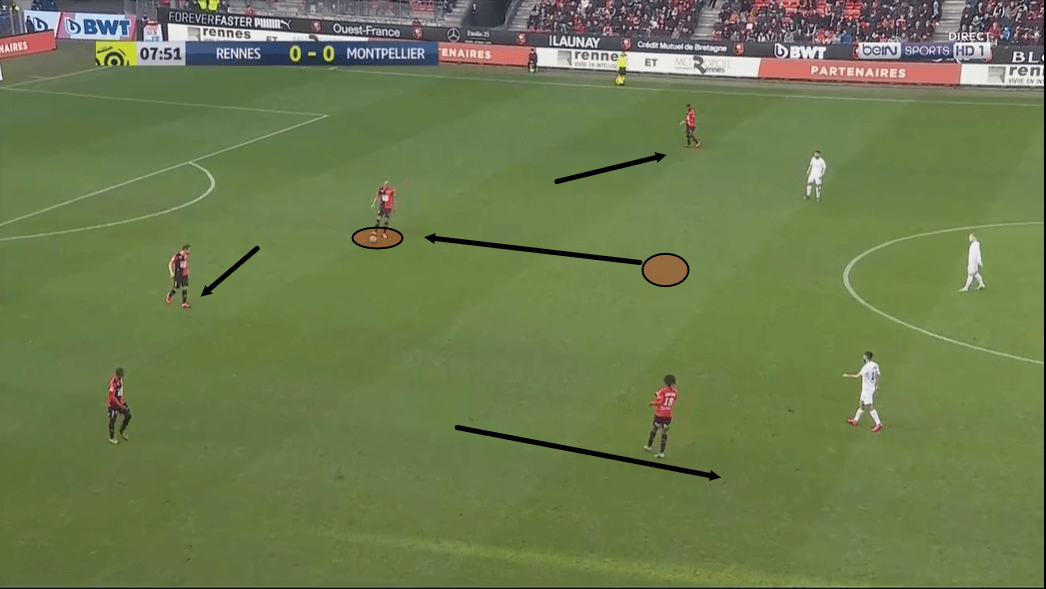
Since Nzonzi has joined Rennes, he has generally been the one dropping between the centre-backs during the build-up. This has allowed Camavinga to enjoy an increased amount of freedom during the attacking phase and he has been able to influence the game positively for his side in the final third much more as a result.
In Ligue 1 this term, Camavinga has made an average of 1.64 progressive runs per game. However, he has made more than that in two of the three games in which he has lined up alongside Nzonzi thus far. He made four progressive runs versus Montpellier and three progressive runs versus Toulouse.
Additionally, 100% of Camavinga’s forward passes were accurate versus both Montpellier and Toulouse, while only 76.3% of his forward passes have been accurate, on average, during the 2019/20 league season. This may indicate that Camavinga has been more precise with his forward passes in this more advanced role, having been given some extra freedom by Nzonzi, who is happy to sit and play deeper.
This provides us with one example of the importance that Nzonzi’s role has played for Rennes thus far. Camavinga is a well-known promising talent, as is evident by the fact that the teenager has already been linked with a move to Spanish giants Real Madrid. Nzonzi’s arrival has essentially ‘freed up’ Camavinga and allowed him to influence the game more in the opposition’s half. It may be fair to say that this has been effective thus far as the youngster got his second assist of the league season in Rennes’ 5-0 win over Montpellier on the eighth of March.
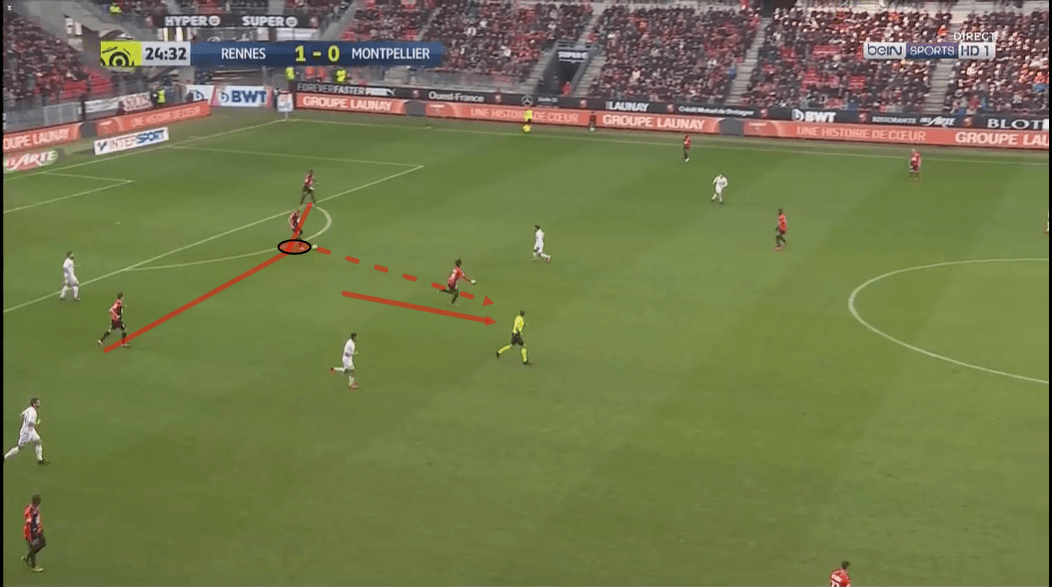
We can see an example of the dynamic that exists between Nzonzi and Camavinga in Rennes’ midfield in the image above. As Rennes begin to build out from the back here, Nzonzi splits the centre-backs via his positioning, while Camavinga begins to dart forward, breaking past the opposition’s midfield line with his run and creating a positive passing angle for Nzonzi, who can play the teenager through and allow his side to break.
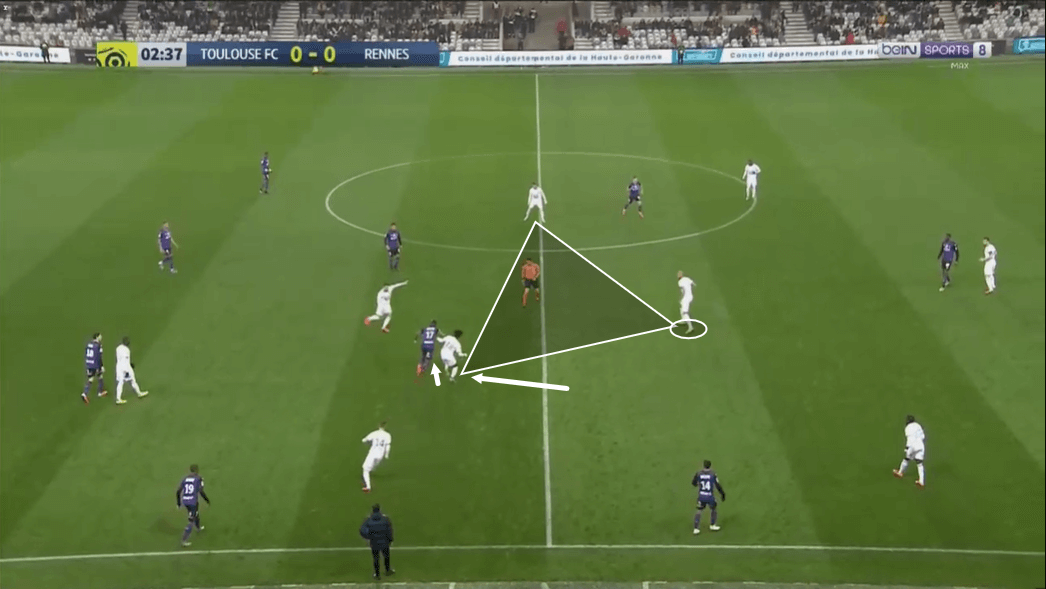
Additionally, the safety net of Nzonzi’s presence at the base of Rennes’ midfield allows Camavinga, who is a more mobile player than Nzonzi, to press higher up the pitch and actively win the ball back for his side, as we can see in this image above.
It hasn’t taken very long for Nzonzi to establish a clear role within Stéphan’s tactics and this Rennes side. The effectiveness of this role and the partnership that is developing between the 31-year-old and Camavinga may be highlighted by the fact that Rennes have won all three of the league games in which these two players played alongside one another.
Nzonzi’s passing ability and more about his role in possession
We’ve discussed some of the important aspects of Nzonzi’s role within this Rennes side in the previous section, however, we will delve further into the 31-year-old’s role in possession in this section and look at how Nzonzi’s role and positioning develop the further that Rennes’ attacks get into the opposition half of the pitch.
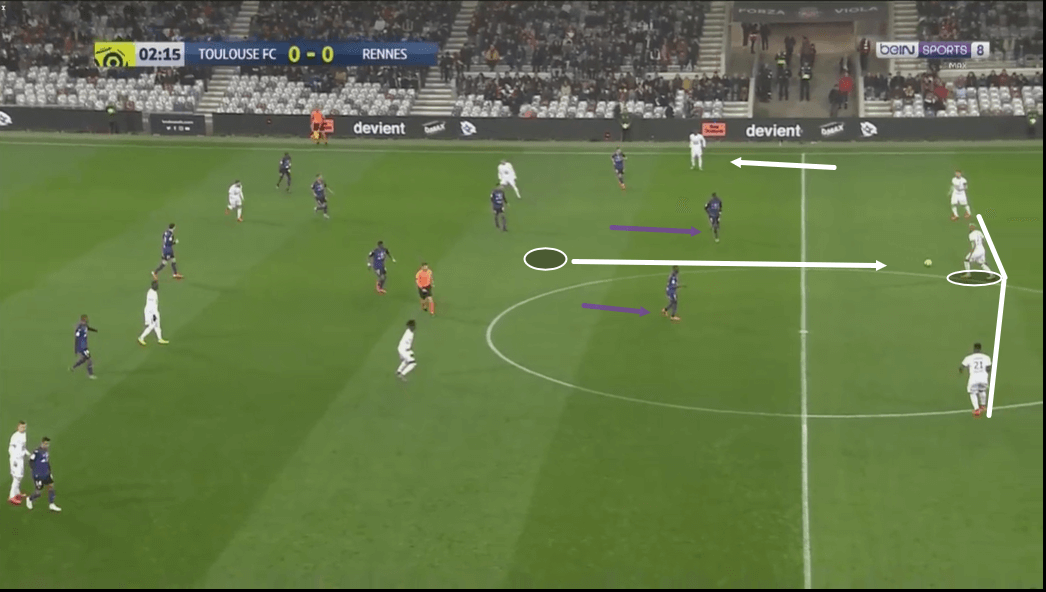
First off, the image above is taken from Rennes’ 2-0 win over Toulouse on the 29th of February. In this game, Rennes lined up in a 4-4-2 shape which saw Nzonzi partner Camavinga in the midfield and Nzonzi continued to perform his role of dropping deep into the defensive line, splitting his side’s centre-backs, in this game, similarly to how he did in the Montpellier game which we looked at in the previous section.
However, on this occasion, he had to vacate his right central midfield position to do so, in a similar fashion to how Camavinga did the same thing when we looked at him dropping between the centre-backs earlier on in this scout report.
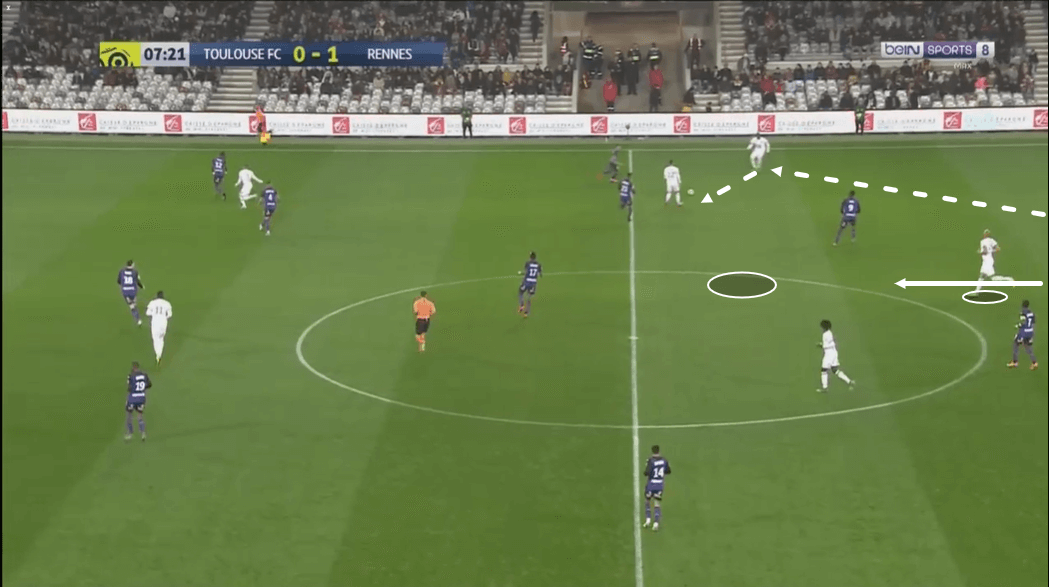
However, in this game, as a part of a 4-4-2 shape, Nzonzi did have to advance his position into the midfield alongside Camavinga as Rennes progressed the ball past Toulouse’s first line of defence and into the middle third of the pitch. We can see this in action in the image above, where Rennes’ right-back is playing the ball to the right-winger while Nzonzi leaves the defensive line and joins Camavinga in midfield.
The purpose of Nzonzi originally dropping between the centre-backs was in order to allow his side to create a 3v2 advantage during that particular phase of the build-up versus Toulouse’s two centre forwards. However, as a part of the 4-4-2 shape, he then has to ensure that he advances into the midfield once the ball progresses beyond his side’s defensive line, in order to ensure that they retain sufficient numbers in the centre of the pitch to succeed in the next phase of play.
As this 4-4-2 shape has been common for Rennes this season, it is important to look at how Nzonzi’s role develops within this system as the ball progresses up the pitch, as more is still required of him as play advances and he needs to remain present in his side’s build-up during this next phase.
In the 4-3-3 system that Rennes deployed versus Montpellier, Nzonzi didn’t have to get himself forward as hastily as he does here and he was allowed to sit deeper for a longer period of time.
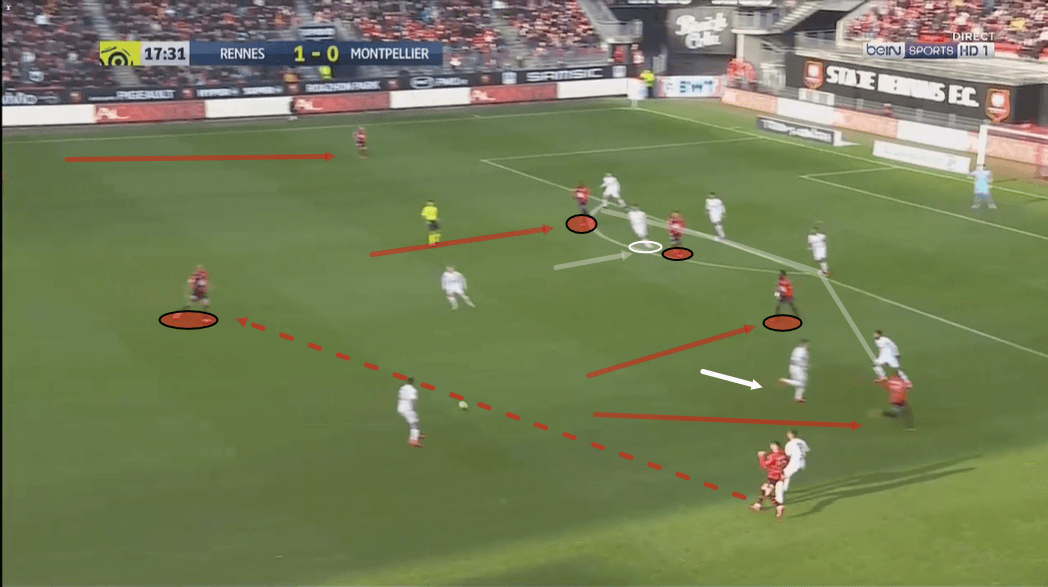
This next image shows us another example from Rennes’ most recent Ligue 1 clash with Montpellier. On this occasion, we can see a basic example of Rennes’ tactics within the final third during this game.
In the final third, Rennes’ two advanced ‘8’s of Camavinga and Léa Siliki advance their positions to occupy the half-spaces, as we can see here. Meanwhile, Rennes’ centre-forward holds his central position, the wingers hold their positions out wide, and the right-back also drives forward and he can be seen playing slightly higher up the pitch than right-winger Romain Del Castillo here.
This creates a difficult offensive shape for Montpellier to defend against. Their back five is forced to stay quite narrow and compact, as we can see, however, all five of them are occupied by an opposition player. Additionally, Rennes’ centre forward also attracts the attention of one opposition midfielder here who tries to block off the short-passing option, while other midfielders are also dragged out of position by the movement of Rennes’ players in attack here.
Rennes’ right-winger can be seen playing the ball from the wing into Nzonzi who is occupying a deeper position than the other six Rennes players that we can see in this image and this provides us with a clear example of Nzonzi’s role within this particular phase of play.
The 31-year-old doesn’t ever get too far forward and his role isn’t to influence the game in the final third. His role during this phase of play is simply to provide an outlet for his more advanced teammates should they need to play the ball backwards, or to act as a player through whom his teammates can play in order to quickly and efficiently switch the play from one wing to the other while minimizing the risk by cutting out the need to perform a long-ball to do so.
Rennes keep the passing option of Nzonzi free in the centre of the pitch thanks to their movement in attack and they subsequently use him to quickly play the ball from the right-wing over to the left-wing where they had created a lot of space due to how they forced Montpellier’s defence to sit so narrow thanks to their offensive tactics.
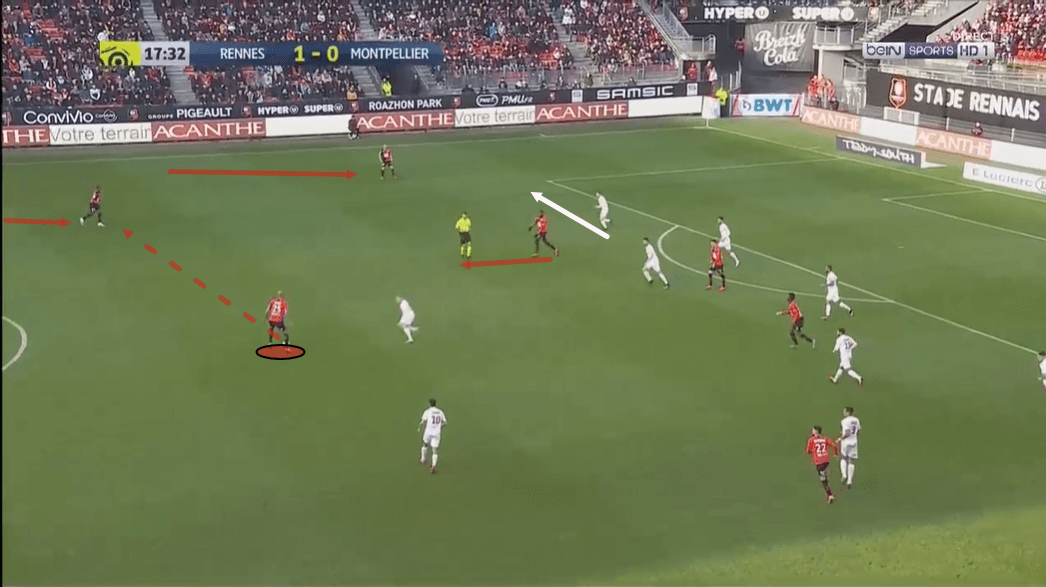
As we can see in this next image, Nzonzi turns and immediately finds a teammate in support, on this occasion, it’s Faitout Maouassa, Rennes’ left-back. Rennes’ switch of play results in Montpellier’s right wing-back pushing out towards Rennes’ left-winger, who is enjoying plenty of space here, however, as he pushes out wide, Léa Siliki intelligently drops deeper into the left half-space, freeing himself up in the process.
This passage of play provides us with an example of some of Rennes’ offensive tactics from this particular game in general, however, this passage of play also allows us to examine Nzonzi’s role within this stage of his side’s attacks.
Nzonzi isn’t in the business of risk-taking at Rennes. He has played only one pass to the penalty area in any of his five Ligue 1 games for the club thus far. He won’t often be seen attempting to make that final pass, however, he can be effective at playing the role of a man who his teammates can play through, in order to either retain possession or get the ball into more dangerous playmakers and into more dangerous positions by using him to switch the play, as we saw here.
Nzonzi is an effective player on the ball, within the role that he plays for Rennes. He doesn’t pull off anything particularly spectacular on the pitch for Les Rouge et Noir, however, that doesn’t appear to be what Stéphan asks of him. Nzonzi’s role within Rennes’ side appears to be to add a sense of calm and reliability to the midfield and the 31-year-old performs that role effectively.
Rennes have played an average of 409 passes per game in Ligue 1 this season and Nzonzi has played an average of 62.27 passes per game in his five Ligue 1 games for Les Rouge et Noir thus far, indicating how involved the midfielder is in the game and it makes sense considering his central role during the build-up and further up the pitch, as we saw here.
Additionally, of Nzonzi’s 62.27 passes per game, only 2.2 of his passes, per game, are categorised as ‘long-passes’ according to Wyscout, which gives us even more of an indication of the type of player and passer that he is within Rennes’ midfield. He has played 94.7% of his Ligue 1 passes accurately for Rennes thus far and that reliability is essential for his role in this side.
Physicality
At 196cm (6’5”) tall and what may be fair to call quite a large build, Nzonzi evidently brings a clear physical presence out onto the pitch. This physical presence is important both for regaining possession and retaining possession, which we will look at in this next section.
Firstly, Nzonzi clearly brings an aerial threat to his side thanks to his size and this has been well-utilised by Rennes in the five league games that the midfielder has played in for them thus far, as Nzonzi has contested 6.82 aerial duels for Rennes on average in his five league fixtures, winning 61.3% of them.
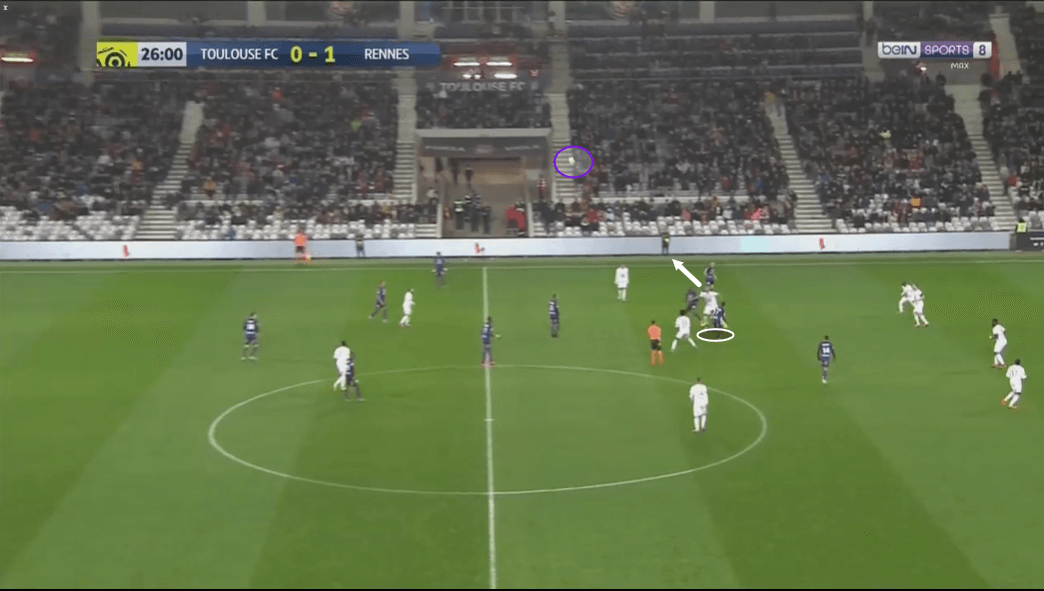
We can see an example of Nzonzi going up to contest an aerial ball against a Toulouse player in the image above after Toulouse had just taken a long goal kick. The 31-year-old’s aerial ability is often utilised effectively in these types of situations after opposition goal kicks and during set-pieces. Nzonzi is a useful asset for Rennes in that regard and his ability to win the ball back in the midfield directly from opposition goal kicks is an important element to his game.
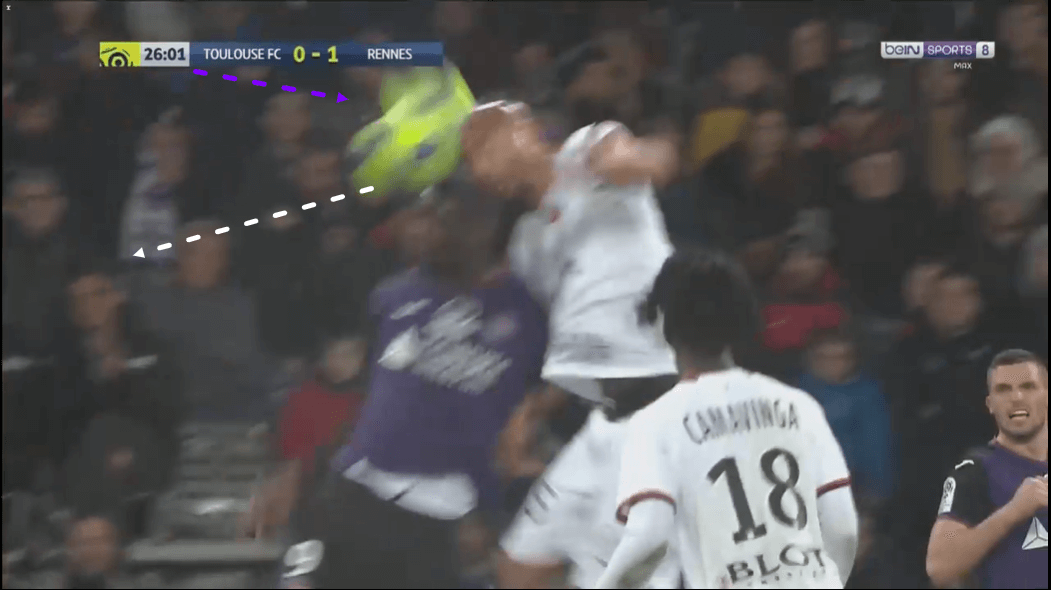
This next image shows us a close-up shot of Nzonzi jumping and towering over Toulouse forward Yaya Sanogo here. As the 31-year-old goes up to contest this aerial duel, he gets above his opponent and knocks the ball down from the opposition goal kick for his teammates to win the second ball in midfield.
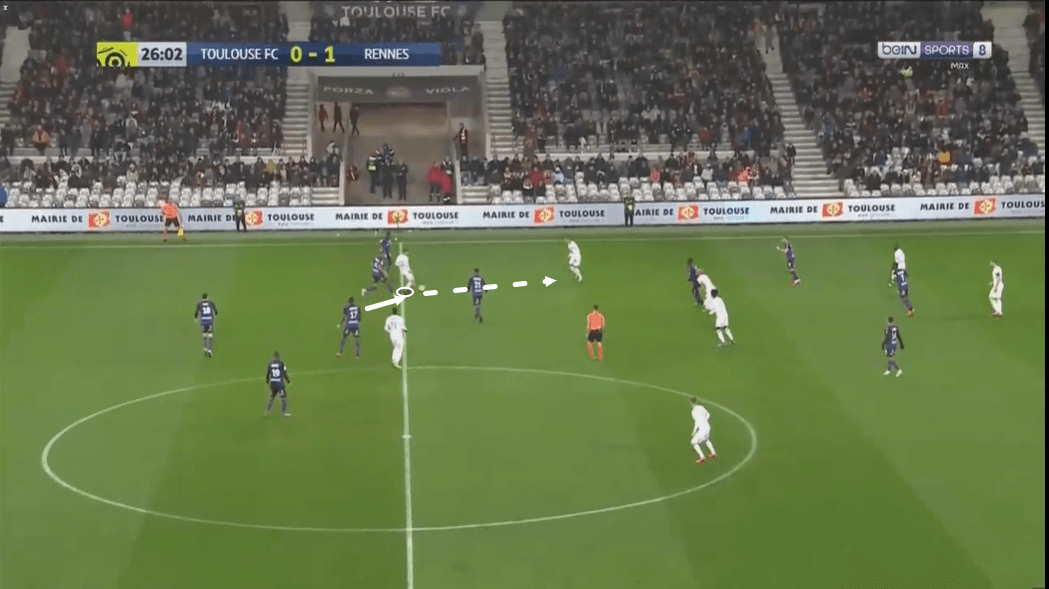
As play moves on, we see that this is exactly what happens and Rennes manage to quickly regain possession following this opposition goal kick in the centre of the park, where they can attempt to kickstart an attack of their own.
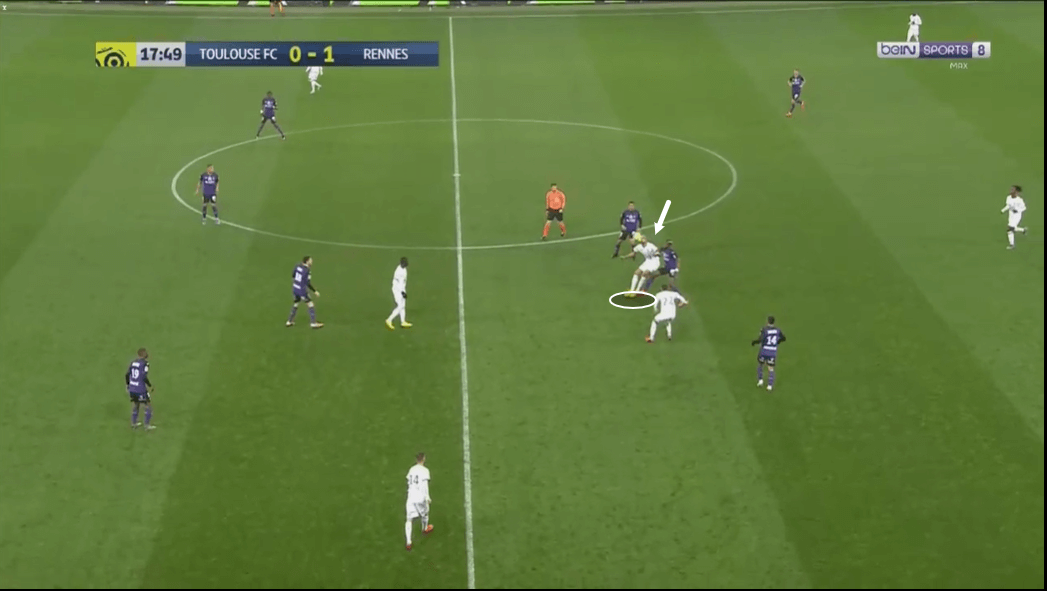
This next image provides another example from this Toulouse game. On this occasion, Nzonzi manages to use his strength and his large frame to outmuscle a Toulouse player as he attempts to receive a lofted pass from his teammate. The Toulouse man is unable to deal with Nzonzi and the Rennes midfielder wins the ball back for his side quite comfortably.
In addition to winning back the ball, Nzonzi’s size and physicality also plays an important role in helping his side in possession. His strength and his large frame are important for shielding the ball from opposition players and retaining possession for his side.
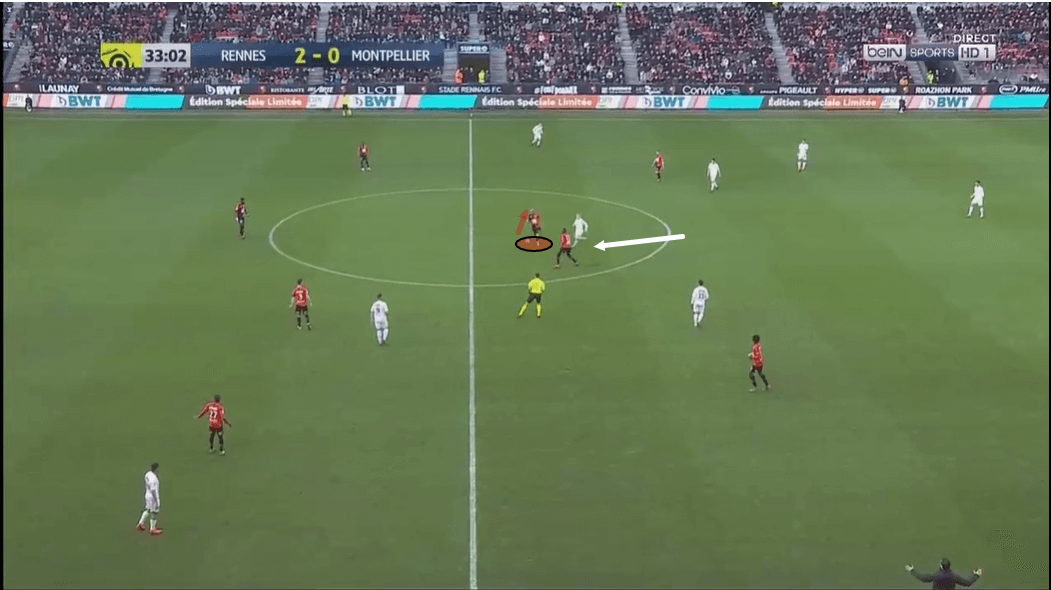
Just prior to this image above being taken, we saw Nzonzi control a long ball well, taking it down in the middle of the park. However, he is quickly pressed by an opposition player, looking to capitalise on the fact that the Rennes man is yet to get the ball completely under control.
However, Nzonzi is a reliable and calm footballer on the ball and as this player begins to press him, he begins to show his back to the on-rushing player as he turns in a clockwise direction to evade this challenge.
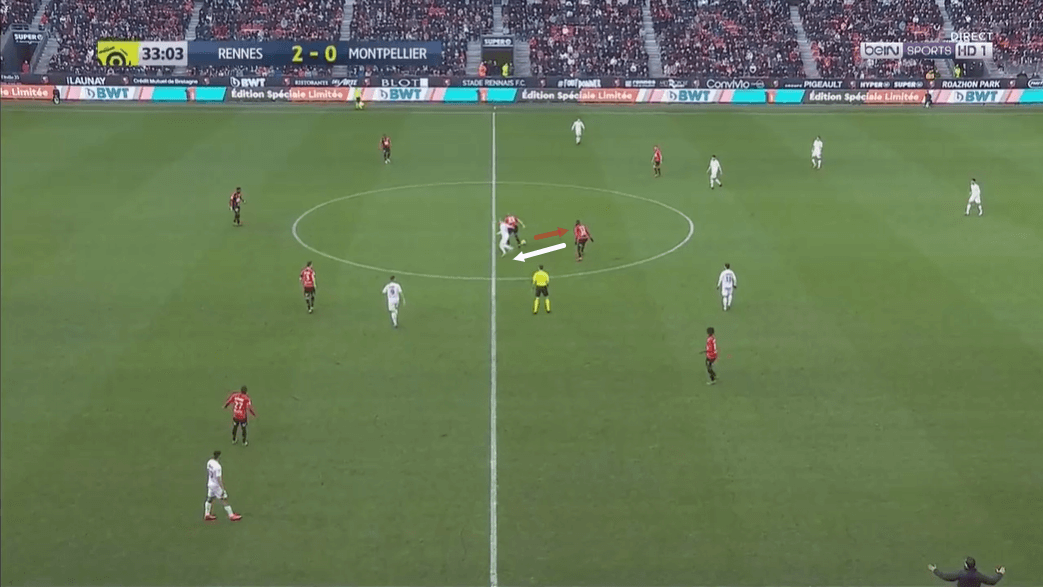
As play moves on, the pressing player ultimately fails to cause too much trouble for Nzonzi who holds him off via his considerable size and strength. He then intelligently and skilfully exits out of this move to his right-hand side, leaving the Montpellier man in his tracks and continuing this attack for Rennes.
Nzonzi’s size and physical traits are clear for all to see and with that in mind, there may not be a whole lot to say about them that isn’t obvious, however, this is an important aspect to his game which helps him to operate effectively in the role which is required of him both in and out of possession within Rennes’ tactics.
Intelligent defensive positioning
While Nzonzi’s size does help him to win back the ball for his side, both via aerial duels and via more grounded physical contests, His intelligent defensive positioning may arguably be an even more important aspect to his game off the ball.
Nzonzi’s ability to read the game is important for him and this Rennes side. Rennes engage in an average of 68.93 defensive duels per game, winning 59.4% of them. Meanwhile, Nzonzi has only engaged in an average of 3.52 defensive duels per game for Les Rouge et Noir in his five games for the club thus far, however, he has been successful in 81.3% of those defensive duels.
This indicates that while Nzonzi isn’t going around and hunting down opposition players like a Camavinga, for instance, who has contested an average of 10.27 defensive duels per game in Ligue 1 this term, the 31-year-old has been efficient and successful at forcing turnovers when he has contested them.
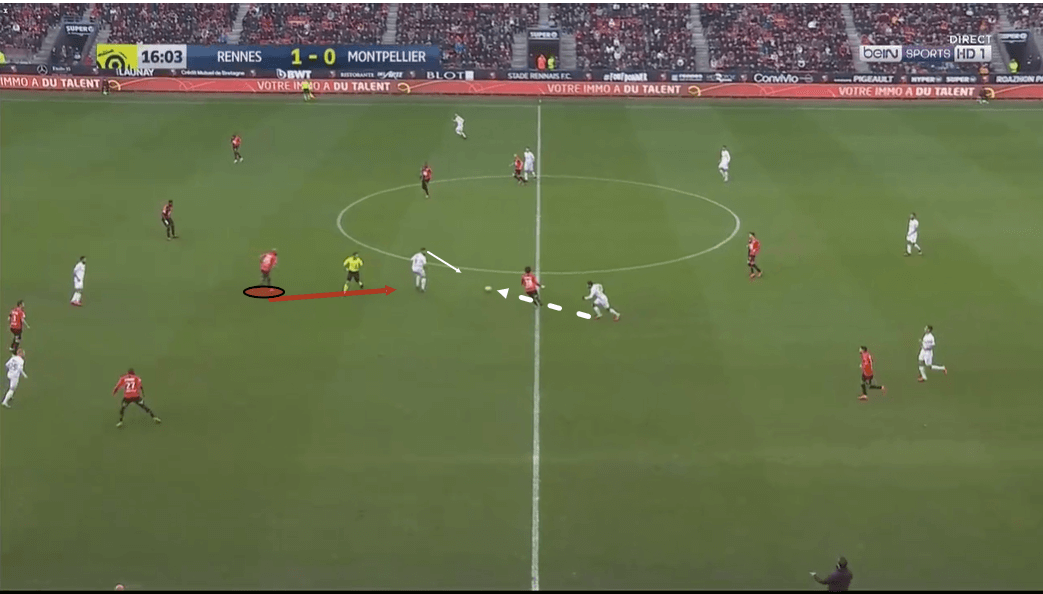
Nzonzi’s intelligent positioning and his excellent reading of the game are important traits of his, which help him to perform efficiently when he does contest defensive duels. In the image above, we can see Nzonzi positioned just in front of his team’s defensive line, performing something of a screening job at this moment.
However, as this player positioned just in front of him receives possession of the ball, Nzomzi begins to advance at a deceptively fast speed, closing the distance between him and this player. Meanwhile, this opposition player fails to make himself aware of the approaching Nzonzi by checking his shoulder, allowing himself less time to prepare a plan to deal with the oncoming defensive player.
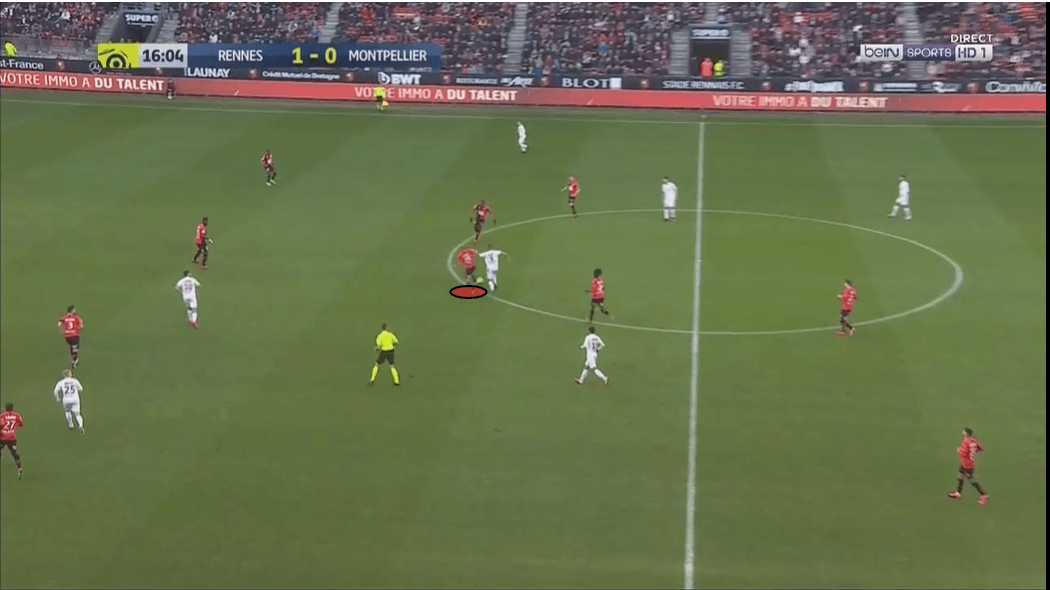
The Montpellier man receives the ball on the inside of his left foot and begins to take the ball towards the right-wing, however, Nzonzi is right there with him and the 31-year-old holding midfielder manages to stick a leg in and win the ball back for his side quite quickly here.
Nzonzi positioned himself well and clearly demonstrated a good reading of the game in this particular passage of play, which helped his side to quickly regain possession of the ball as soon as the opposition entered their half of the pitch.
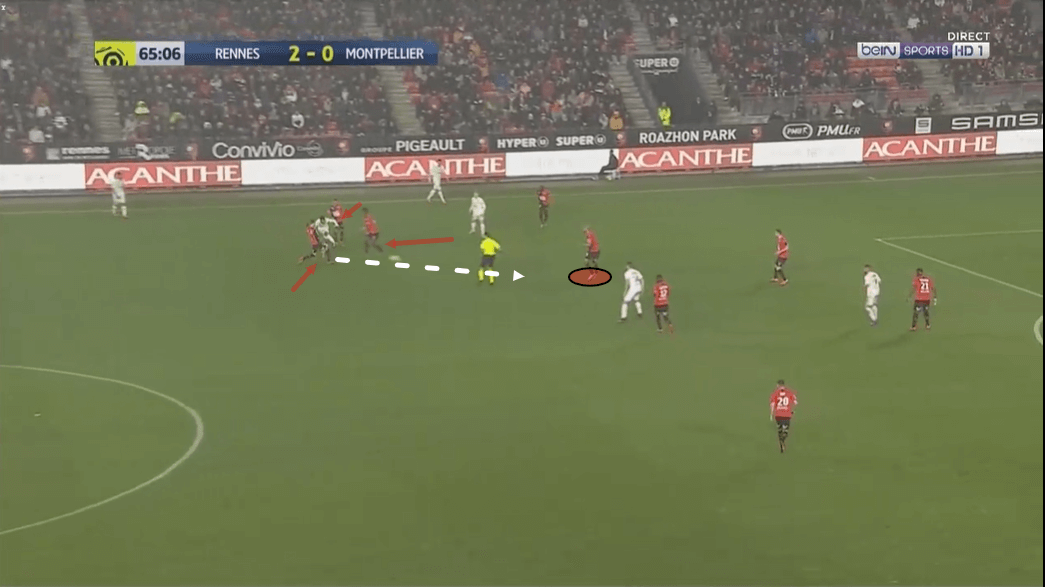
Additionally, Nzonzi is good at positioning himself effectively to essentially draw the opponent’s passes to him when they advance into the final third, as we can see in the image above. Nzonzi’s positioning combines well with the pressing from some of Rennes’ more positionally advanced players here to leave this Montpellier ball carrier with essentially no option but to give away possession.
Rennes’ pressing players narrow the passing angles and cut off passing options for the ball carrier, essentially leaving him with one passing option, which is to try and find the central player in front of him in the midfield, however, Nzonzi positions himself to the right of this player, in the space where he anticipated that this ball would be played if the passer were to try and play a ball into the path of this more advanced player’s run.
As play moves on, this is exactly what happens and Nzonzi happily welcomes the ball to the inside of his right foot and he and his Rennes side can then begin an attack of their own.
Conclusion
To conclude this tactical analysis piece in the form of a scout report, it’s clear that Nzonzi’s calmness and reliability on the ball, in addition to his intelligent ability to position himself off the ball, as well as his physical attributes, are all important aspects to his game.
Nzonzi isn’t the type of player who you want to send out to play extravagant passes or to run around, chasing the ball non-stop and if asked to perform either of these two tasks, he would, in all likelihood, perform very ineffectively. However, Nzonzi is an intelligent reader of the game, a calming presence on the ball, and someone who you can rely on to not lose the ball easily.
This is the role that Stéphan asks him to play at Rennes and he performs this role very well. When combined with the likes of Camavinga and Léa Siliki in the midfield, Nzonzi can provide an excellent balance to his side, which has made Rennes’ midfield difficult for Ligue 1 sides to deal with in the games that he has featured in for Les Rouge et Noir thus far.





Comments